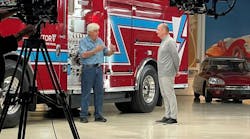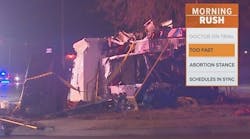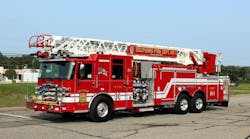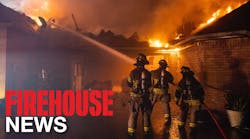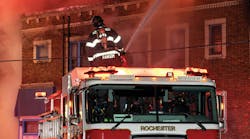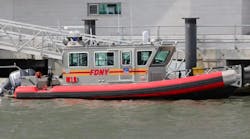Part 35 Ordering New Apparatus and Protecting Your Department's Assets: Understanding Performance Bonds and Bid Bonds
After many months of meetings and planning, your fire department is about to go out to bid for the new pumper. Some would think that the majority of the hard work is about to wind down, but unless your apparatus committee has taken the time to carefully read the "Instructions to Bidders" or boiler-plate portion of your specifications, you may find out that you are missing some important items that can protect the department's interests once the contract is signed with the successful bidder.
Some departments make the mistake of using a manufacturer's standard specifications to incorporate into their final published specifications. While this might provide for a starting point for further discussions, understand that most if not all of this specification language will generally favor the manufacturer and may leave out some of the more important requirements that the department would want to have stipulated within their specifications. Without question the specifications should require that all aspects of the completed apparatus be in compliance with the current edition of the National Fire Protection Association (NFPA) 1901 Automotive Fire Apparatus Standard. You should not allow any bidder to take exception to a portion of your specifications that would violate any NFPA standard and where the specifications call for components or equipment that are above the minimum NFPA requirements these should be noted as well.
One important aspect is to outline how bidders will note exceptions and clarifications to your specifications. An exception should be noted for every item where the bidder cannot meet the intent of the requirement by make or model of a component or cannot provide the requested component or design. The exception should be noted on a separate page within the bid and explained in detail what the bidder intends to provide. A clarification should be offered only where there may be a model-number change or other component upgrade for a specified item within the specifications; i.e., the model of self-contained breathing apparatus (SCBA) seat has changed due to product improvement. Include this statement: "Proposals taking total exception to the published specifications or stating that the bidders proposal takes precedence over the published specifications will be immediately rejected as being non-responsive without further explanation." This protects the fire department from allowing bidders to submit their own specification without having to detail the differences between the department's specifications and the bidder's proposal.
Over the past year, there have been several unfortunate incidents where both communities and departments have made full or partial payments to manufacturers only to have the builders declare bankruptcy or otherwise delay the completion of apparatus without recourse. In some cases, departments have lost all of their money and have nothing to show for their effort, in addition to having to face the public embarrassment of not adequately securing their funds in the process.
There are several methods that you can use to ensure the financial stability of the manufacturer that you are considering to build your new apparatus. First, your specifications should require that each bidder submit a Dun & Bradstreet financial report with the bid proposal. This will provide the department with a good picture of the bidder's financial backing and stability and can assist you in making a wise purchasing decision. Also, if a concerned citizen asks what you have done to protect the governing body and the taxpayers if something goes wrong, you can honestly say you have done all that you can. In addition, the bid should require a bid bond in the amount of either 5% or 10% of the total bid. This bond provides insurance to the department that if chosen, the manufacturer will enter into a contract for the apparatus at the stated price. Any reputable manufacturer is capable of providing a bid bond to back up their ability to successfully offer bids for new apparatus.
Perhaps the most important item to include in your "Requirements to Bidders" section of the specifications is to require a performance bond for 100% of the contract amount. This bond will provide assurance that the successful bidder will supply the apparatus in accordance with the requirements specified in the contract.
While a performance bond does cost money, it should be mandatory for each of your apparatus contracts, especially where the department has agreed to pay a portion of the contract amount up front or as progress payments in return for a discount from the initial price offered in the bid proposal. If you decide to pay for the chassis once it is completed or procured from another vendor, you should try to obtain title or some kind of ownership before handing over any money. The downside to that, however, is if the body builder does not produce a body to your expectations, you now own a chassis with a not-so-great body. The bond provides security for any pre-payments made by the department and ensures some degree of confidence that the successful bidder will supply the completed apparatus as specified. Failure to require a performance bond leaves the municipality and the department at the mercy of the contractor and provides no assurance when and how the apparatus will be built.
Recently, a village fire department in New York entered into a contract with a manufacturer for a new custom pumper. Along with this the village chose to pre-pay over $320,000 without requiring a performance bond for the new apparatus. As a result, when the manufacturer filed for bankruptcy, the village's deposit was put at risk with nothing to show for its efforts. These situations unfortunately develop each year as both government officials and fire departments fail to protect themselves when entering into contracts for new apparatus.
Other items to consider include a statement regarding the number of calendar days necessary to build and deliver the new apparatus to your department. While some consider the calculation of working days to be more important, it is best to allow each bidder to state its best delivery period in calendar days from the receipt of contract and then to provide for a reasonable-penalty clause for late delivery if this time frame is not met without a reasonable explanation by the manufacturer. (Note: If the penalty clause becomes outrageous, the manufacturer may never want to complete an apparatus when the penalty clause would erase any expected profit.)
Requirements for inspection trips and the pre-construction conference should be specified detailing the number of department personnel who will attend, together with who is responsible for the cost of travel, lodging and meals. Some departments prefer to have the successful bidder be responsible for all of these travel costs as local budget constraints prohibit them from having a separate line item for related inspection expenses. Other departments would rather pay for all of the inspection costs themselves in order to provide a lowest possible cost for the apparatus and equipment.
If the manufacturer is to be responsible for all inspection costs, consider identifying this cost separately to let your committee clearly establish the actual cost of the apparatus. In this manner, builders who are farther away with attendant higher travel costs would not be placed at a disadvantage due to airfare and other expenses unrelated to the apparatus. This puts all bidders on an even playing field.
While most apparatus committees will spend their time working on the technical portion of the specifications, the boiler-plate area is equally important. The assistance of an apparatus architect who is experienced in dealing with both fire department requirements and the operational characteristics of the apparatus builders can play a vital role in the success of your new apparatus.
The next installment of "The Apparatus Architect" will discuss safety-related components and designs to consider on your next unit.
TOM SHAND, a Firehouse® contributing editor, is a 33-year veteran of the fire service and works with Michael Wilbur at Emergency Vehicle Response, consulting on a variety of fire apparatus and fire department master-planning issues. He is employed by Seagrave Fire Apparatus LLC as a regional sales manager. MICHAEL WILBUR, a Firehouse® contributing editor, is a lieutenant in the New York City Fire Department, assigned to Ladder Company 27 in the Bronx, and has served on the FDNY Apparatus Purchasing Committee. He consults on a variety of apparatus-related issues around the country. For further information, access his website at www.emergencyvehicleresponse.com.
